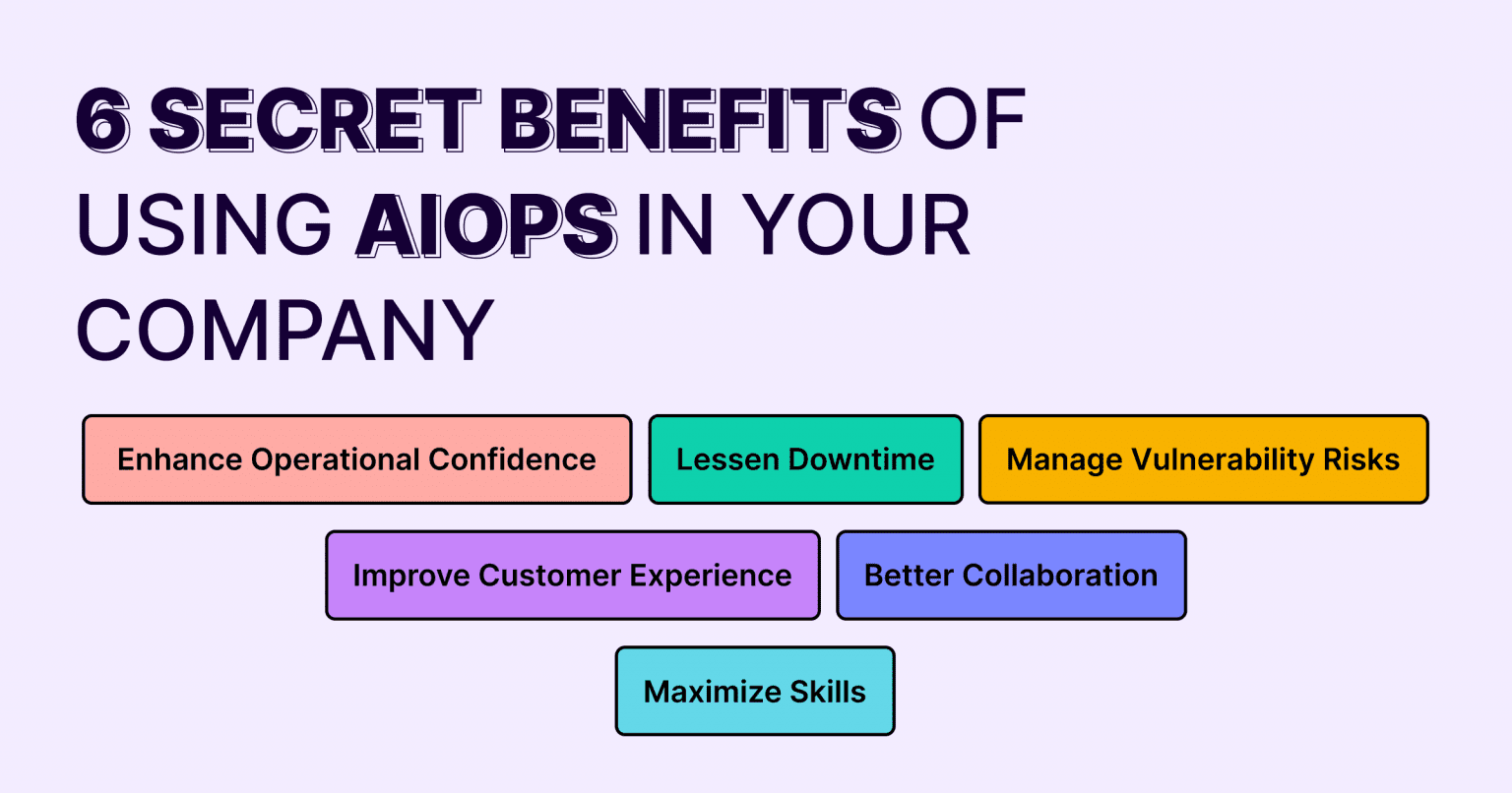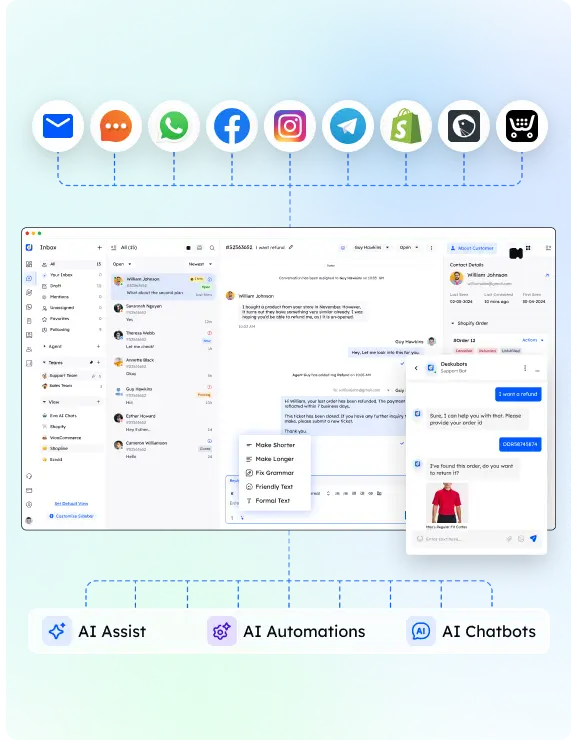As IT infrastructures expand and become more complex, managing their scale and intricacies is increasingly challenging. The vast amount of data produced by these systems is formidable. Without advanced and intelligent monitoring and analysis tools, this can lead to overlooked alerts, missed opportunities, and costly downtime.
Enter the era of big data and machine learning, giving rise to a novel category of IT operations tools: AIOps. This innovation leverages the power of artificial intelligence to transform how IT environments are managed, offering a sophisticated solution to the daunting challenges of modern IT operations.
It’s the time to cherish the most stunning benefits of using AIOps.
How can AIOps Elevate Your Company’s IT Operations
| Operational Challenge | Traditional Approach | AIOps Advantage |
| Maintaining Network Configuration Compliance | Static device settings struggle to keep up with changing business needs. | AIOps continuously monitors network operations, recommending or automatically making optimization changes. |
| Addressing Changing Business Needs | Service Level Expectations (SLEs) must be manually configured, which is costly and time-consuming. | Network thresholds are automatically defined, monitored, and adjusted based on environmental changes. |
| Resolving Network Issues Quickly | Help desk calls, which are expensive and inefficient, are the primary method for identifying problems. | Preemptive insights identify issues before they impact users or IoT devices, reducing help desk calls. |
| Replicating Intermittent Issues | Significant time is spent tracking down intermittent problems due to their difficult nature to replicate. | Automated, always-on monitoring distinguishes persistent vs. apparent problems, with built-in data capture for analysis. |
| Increasing Network Complexity | Over 50% of IT time is consumed by troubleshooting and optimization tasks. | AIOps provides insights including reasons for failures, root cause analysis, and repair recommendations. |
| Lacking Resources and Skills | A constant contention point is the lack of resources and training. | AIOps offers insights and search features designed to assist and enhance the team’s knowledge base. |
The Importance of AIOps
Before cherishing the benefits of using AIOps, let’s check the root importance. Imagine AIOps as this super smart assistant that’s always on, always watching. It takes in all the data flowing through your IT systems in real-time—kind of like drinking from a firehose—but it’s designed to handle it.
This allows it to give you constant updates and insights about what’s happening across your IT operations. It’s like having a vigilant guardian that’s always on the lookout, making sure everything’s running smoothly and alerting you if something’s off.
AIOps capabilities include:
- Processing streaming data in real-time for ongoing IT operations insights.
- Detecting anomalies and outliers to identify unusual behavior.
- Identifying malware traffic to enhance security measures.
- Detecting vulnerabilities for improved system safety.
- Analyzing historical data for trend identification.
- Analyzing performance for optimization opportunities.
- Conducting root cause analysis to pinpoint issue origins.
- Offering remediation advice for swift problem resolution.
The Six Major Benefits of Using AIOps
Time Savings through Automation of Routine Tasks with AIOps
Automating Repetitive Tasks:
- What it does: Takes over routine, manual tasks that are time-consuming for humans.
- Why it’s beneficial: Frees up IT staff to focus on more strategic and complex problems, enhancing productivity and job satisfaction.
Quick Issue Resolution:
- What it does: Uses machine learning to identify and solve problems faster than traditional methods.
- Why it’s beneficial: Reduces downtime and improves system reliability by ensuring issues are resolved quickly, often before users even notice.
Reducing Human Errors:
- What it does: Automates processes that are prone to human error, ensuring tasks are performed consistently and accurately.
- Why it’s beneficial: Increases operational reliability and efficiency by minimizing mistakes that can lead to bigger issues down the line.
Enhanced Decision Making:
- What it does: Provides actionable insights based on data analysis, supporting more informed decision-making.
- Why it’s beneficial: Helps teams make smarter, data-driven decisions quickly, aligning actions closely with organizational goals and user needs.
Continuous Optimization:
- What it does: Learns from ongoing operations to optimize IT processes continuously.
- Why it’s beneficial: Ensures that operations are not just efficient today but keep improving over time, adapting to new challenges and requirements.
Enhanced Reliability and Availability of Support Teams with AIOps
24/7 Monitoring:
- What it does: Constantly watches over your IT systems, catching issues before they escalate.
- Why it’s beneficial: Prevents downtime by ensuring any potential problems are addressed immediately, keeping services running smoothly around the clock.
Automated Issue Detection:
- What it does: Instantly identifies when something goes wrong, using machine learning to spot anomalies.
- Why it’s beneficial: Speeds up the response time to issues, reducing the impact on your operations and enhancing system stability.
Proactive Problem Prevention:
- What it does: Predicts and addresses issues before they actually happen, based on pattern analysis and predictive algorithms.
- Why it’s beneficial: Minimizes interruptions by avoiding problems in the first place, ensuring a seamless operational experience.
Rapid Response Readiness:
- What it does: Keeps your support team alert with real-time data and analytics, enabling quick action.
- Why it’s beneficial: Improves the efficiency and effectiveness of your support team, ensuring they can quickly resolve issues as they arise.
Actionable Insights for Resolution:
- What it does: Provides deep insights into the root causes of problems, suggesting actionable steps for resolution.
- Why it’s beneficial: Empowers your team with the knowledge to not just fix issues faster but also to understand them better, leading to more effective long-term solutions.
Boosted Team Productivity:
- What it does: Automates routine tasks, freeing up your team to focus on more complex and strategic work.
- Why it’s beneficial: Enhances job satisfaction and team output by allowing staff to concentrate on tasks that require human intelligence and creativity, rather than monotonous, repetitive work.
Benefits of Using AIOps: Boosting the Customer Experience
Proactive Issue Resolution:
- What it does: Identifies and resolves issues before they impact the customer experience.
- Why it’s beneficial: Prevents service disruptions and ensures a seamless user experience, significantly enhancing customer satisfaction.
Personalized User Experiences:
- What it does: Analyzes user behavior and preferences to tailor services and interactions.
- Why it’s beneficial: Delivers a more personalized and engaging experience, leading to increased loyalty and customer retention.
Rapid Response to Customer Needs:
- What it does: Enables quicker reactions to customer inquiries and problems through automation and predictive insights.
- Why it’s beneficial: Improves service response times, ensuring customers feel valued and supported, which is crucial for maintaining a positive brand reputation.
Continuous Service Improvement:
- What it does: Utilizes feedback and operational data to drive ongoing enhancements in services and products.
- Why it’s beneficial: Ensures that customer-facing services evolve in line with user expectations and emerging trends, keeping the business competitive.
Enhanced Quality of Service:
- What it does: Optimises system performance and reliability, reducing downtime and errors.
- Why it’s beneficial: Provides customers with reliable and efficient services, which is foundational to a positive customer experience.
Transitioning to More Sustainable IT with AIOps
Optimising Resource Utilisation:
- What it does: Ensures that computing resources are used efficiently, avoiding waste.
- Why it’s beneficial: Reduces energy consumption and operational costs, contributing to a greener and more cost-effective IT infrastructure.
Data Center Efficiency:
- What it does: Analyses and improves data center operations, from cooling systems to server utilization.
- Why it’s beneficial: Increases energy efficiency and reduces the carbon footprint of data centers, making IT operations more sustainable.
Reducing Electronic Waste:
- What it does: Extends the lifespan of IT equipment through predictive maintenance and optimal usage.
- Why it’s beneficial: Decreases the amount of electronic waste generated, contributing to environmental conservation and sustainability.
Facilitating Remote Work:
- What it does: Supports and optimizes remote work environments through efficient network management and resource allocation.
- Why it’s beneficial: Reduces the need for physical office spaces and commuting, lowering overall carbon emissions associated with daily operations.
Smart Energy Management:
- What it does: Implements intelligent systems to monitor and control energy use across IT infrastructures.
- Why it’s beneficial: Minimizes unnecessary energy consumption during low-demand periods, aligning energy usage with actual operational needs.
Reducing Security Risks with Artificial Intelligence for IT Operations (AIOps)
Advanced Threat Detection:
- What it does: Utilizes AI and machine learning to analyze patterns and detect anomalies that may indicate a security threat.
- Why it’s beneficial: Enables early detection of potential security breaches, reducing the likelihood of significant damage or data loss.
Automated Incident Response:
- What it does: Automatically responds to identified threats, potentially neutralizing them before they can cause harm.
- Why it’s beneficial: Decreases response times to security incidents, minimizing impact and enhancing system resilience.
Continuous Security Monitoring:
- What it does: Provides round-the-clock surveillance of IT systems to identify and alert on potential security issues.
- Why it’s beneficial: Ensures constant vigilance over the security landscape, keeping systems safe and secure at all times.
Predictive Security Insights:
- What it does: Analyzes historical data to predict future security threats and vulnerabilities.
- Why it’s beneficial: Offers a proactive approach to security, allowing IT teams to address vulnerabilities before they are exploited.
Enhanced Compliance Management:
- What it does: Helps ensure that IT operations comply with relevant security standards and regulations by automating compliance processes.
- Why it’s beneficial: Reduces the risk of compliance violations and associated penalties, while also safeguarding sensitive data.
Enhanced Collaboration Between Departments with AIOps
Centralising Data Insights:
- What it does: Aggregates and analyzes data from across the entire IT landscape, providing a single source of truth accessible to all relevant departments.
- Why it’s beneficial: Ensures consistency in decision-making processes and strategies, reducing conflicts and misunderstandings that can arise from disparate data sources.
Automating Communication Flows:
- What it does: Facilitates automatic updates and alerts related to system status, issues, and resolutions across departments.
- Why it’s beneficial: Keeps everyone informed in real-time, enhancing responsiveness and enabling more coordinated actions across teams.
Facilitating Proactive Problem Solving:
- What it does: Employs predictive analytics to identify potential issues before they become problems, allowing for cross-departmental preemptive action.
- Why it’s beneficial: Encourages proactive collaboration and innovative problem-solving, leveraging the collective expertise of various departments.
Streamlining Workflow and Processes:
- What it does: Integrates with various tools and platforms used across departments, automating workflows and processes for better efficiency.
- Why it’s beneficial: Reduces manual handoffs and delays, enhancing operational efficiency and project delivery times.
Promoting Knowledge Sharing:
- What it does: Provides a platform for sharing insights, best practices, and solutions derived from AI-driven analyses.
- Why it’s beneficial: Builds a culture of learning and continuous improvement, leveraging collective knowledge for better outcomes.
Decreasing IT Operations Costs with AIOps
Automating Routine Tasks:
- What it does: Takes over manual, repetitive tasks that typically consume considerable time and resources.
- Why it’s beneficial: Saves on labor costs and allows skilled IT professionals to focus on high-value activities, enhancing overall productivity and reducing operational costs.
Enhancing System Efficiency:
- What it does: Optimizes the performance of IT systems through predictive maintenance and real-time adjustments.
- Why it’s beneficial: Improves resource utilization, reducing the need for overprovisioning and unnecessary hardware or software expenditures.
Reducing Downtime:
- What it does: Minimises system outages through proactive monitoring and rapid issue resolution.
- Why it’s beneficial: Decreases the financial losses associated with downtime, including lost productivity, revenue, and damage to brand reputation.
Optimizing Cloud Costs:
- What it does: Utilizes AI to manage and allocate cloud resources dynamically, ensuring cost-efficiency.
- Why it’s beneficial: Prevents overspending on cloud services by scaling resources in alignment with actual needs, avoiding waste.
Streamlining Incident Management:
- What it does: Automates the detection, diagnosis, and resolution of IT incidents.
- Why it’s beneficial: Lowers the cost of incident management by reducing the time and resources needed to address issues, thereby improving service quality and customer satisfaction.
Challenges of Implementing AIOps
Before planning to reap out the benefits of using AIOps, you need to be aware of a few potential challenges too. Integrating artificial intelligence (AI) into IT operations promises transformative benefits but comes with its own set of challenges. Here’s a more polished exploration of the hurdles organizations may encounter:
1. Data Accuracy Concerns
Data serves as the foundation for AI-driven operations. However, ensuring its accuracy can be daunting due to various factors:
- Human Error: Even minor mistakes in data entry or processing can skew AI outcomes, leading to flawed decision-making or automated actions.
- Outdated Information: The dynamic nature of IT environments means data can quickly become obsolete, misleading AI algorithms and potentially compromising operations.
- Technical Glitches: System errors or malfunctions can corrupt data integrity, affecting the reliability of AI-driven insights and actions.
Mitigating these issues demands rigorous data management practices, including regular audits, updates, and error-checking mechanisms to maintain the quality and relevance of data feeding into AI systems.
2. Lack of Clear Adoption Strategies
Successfully integrating AI into IT operations requires a well-defined strategy:
- Directionless Implementation: Without a coherent plan, organizations may underutilize AI capabilities, struggle to align AI with existing processes, or face operational disruptions during integration.
- Strategic Planning Necessity: A structured approach to AI adoption is essential for harmonizing AI tools with operational goals, ensuring technology investments yield maximal benefits and truly enhance operational efficiency.
3. Skill Gaps and Training Needs
The successful deployment of AIOps hinges on having a team equipped with the necessary AI skills:
- Understanding AI: A significant knowledge gap can hinder the effective integration of AI technologies into IT operations, affecting overall performance.
- Talent Acquisition Challenges: The high demand for AI expertise often exceeds supply, making it difficult to recruit personnel with the required skills for AIOps projects.
- Importance of Skill Development: Investing in training and development programs to upgrade the AI competencies of IT teams is crucial for overcoming these hurdles and leveraging AIOps to its full potential.
Addressing the Challenges
To navigate these challenges, organizations must prioritize robust data governance, strategic planning for AI adoption, and ongoing skill development.
Fostering a culture of continuous learning and innovation is key to minimizing the impact of these obstacles and maximizing the benefits of AI in IT operations.
This proactive approach ensures not only the smooth integration of AIOps solutions but also their sustained effectiveness in enhancing IT operational efficiency and agility.
How Does AIOps Work
Think of AIOps as this incredibly smart system in the heart of your IT operations. It’s like having a super-sleuth detective that can sift through mountains of data in no time. Here’s the magic it does:
- Data Ingestion: Imagine your IT environment as a bustling city with data flowing like traffic. AIOps steps in as the traffic controller, taking in both the old (historical data) and the new (real-time streaming data), ensuring nothing important gets missed.
- Noise Filtering: Now, not all that data traffic is useful; some of it’s just noise—like those unnecessary honks in a traffic jam. AIOps is smart enough to filter out this noise, making sure only the important signals get through for analysis.
- Pattern Discovery: With the relevant data in hand, AIOps turns detective, spotting patterns and connections that no human could catch. It’s like finding needles in haystacks, but at lightning speed.
- Alerts and Events: When AIOps spots something out of the ordinary—say, a potential problem—it doesn’t just note it down; it rings the alarm bells. This way, issues get flagged before they turn into big problems.
- Root Cause Identification and Solutions: But AIOps doesn’t stop at just pointing out problems. It dives deeper to figure out why something went wrong and comes up with ways to fix it. Sometimes, it can even fix issues on its own, like an auto-pilot correcting the course.
Conclusion
Embracing AIOps within your company unlocks six major benefits, revolutionizing how IT operations are managed. From dramatically enhancing efficiency and reducing downtime to predictive analytics and improved decision-making, AIOps serves as a cornerstone for digital transformation. This innovative approach not only streamlines operations but also significantly improves service quality and customer satisfaction. Adopting AIOps positions companies to thrive in the fast-paced digital era, staying ahead of emerging challenges and capitalizing on new opportunities with unparalleled agility and insight.
FAQS for the Best Benefits of Using AIOps
Q. What are AIOps’ primary advantages?
A. AIOps streamA. AIOps aims to automate and improve IT operations, using AI to analyze data for insights, predict issues, and facilitate faster decision-making.lines IT operations through automation, enhances system reliability with proactive issue resolution, and significantly reduces operational costs by optimizing processes.
Q. What role does AIOps play?
A. AIOps aims to automate and improve IT operations, using AI to analyze data for insights, predict issues, and facilitate faster decision-making.
Q. How does artificial intelligence (AI) benefit us?
A. AI improves efficiency through automation, enhances decision-making with data-driven insights, and fosters innovation by solving complex problems.
Q. What are the top benefits of AI for IT operations?
A. AI boosts operational efficiency, enhances cybersecurity with predictive analytics, and improves service availability through real-time monitoring and automation.










